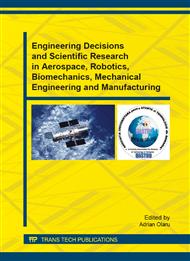p.326
p.337
p.345
p.351
p.358
p.366
p.374
p.382
p.390
Optimization of the Accuracy of Automotive Parking for the Car-Type Mobile Robot
Abstract:
The autonomous ability of the system, which enables it to park itself without any human interference, finds its application mostly in automobile industry. Though the basic algorithm of autonomous parking is relatively simple, the question of reliability and accuracy of parking can be quite complicated. The mathematical models developed theoretically and simulated numerically not always can in the same accurate way perform in a real vehicle. One of the main reasons for it is the interplay between the controlling system and mechanical structure of the vehicle. To investigate this problem the car-type robot simulating the specific features of the mechanical structure of the real car was developed. It was used for verification of few parking approaches proposed in the literature. A parking algorithm was proposed and programmed for a developed car-type robot. The experimental comparison between theoretically calculated and actually observed values of main parking parameters was done and analysed. The approach of optimization of parking strategy from the view point of minimization of positioning errors was proposed and tested.
Info:
Periodical:
Pages:
358-365
Citation:
Online since:
October 2013
Keywords:
Price:
Сopyright:
© 2013 Trans Tech Publications Ltd. All Rights Reserved
Share:
Citation:


